SaaS module
This module implements the User and Role system of an application;
- Manage tenants and editions in the system. A tenant is allowed to have one edition.
- Set features of tenants.
- Set connection string of tenants.
- Set features of editions.
See the module description page for an overview of the module features.
How to install
Saas is pre-installed in the startup templates. So, no need to manually install it.
Packages
This module follows the module development best practices guide and consists of several NuGet and NPM packages. See the guide if you want to understand the packages and relations between them.
You can visit SaaS module package list page to see list of packages related with this module.
User interface
Menu items
SaaS module adds the following items to the "Main" menu, under the "Administration" menu item:
- Tenants: Tenant management page.
- Editions: Edition management page.
SaasHostMenuNames and SaasTenantMenuNames classes have the constants for the menu item names.
Pages
Tenant management
Tenant page is used to manage tenants in the system.
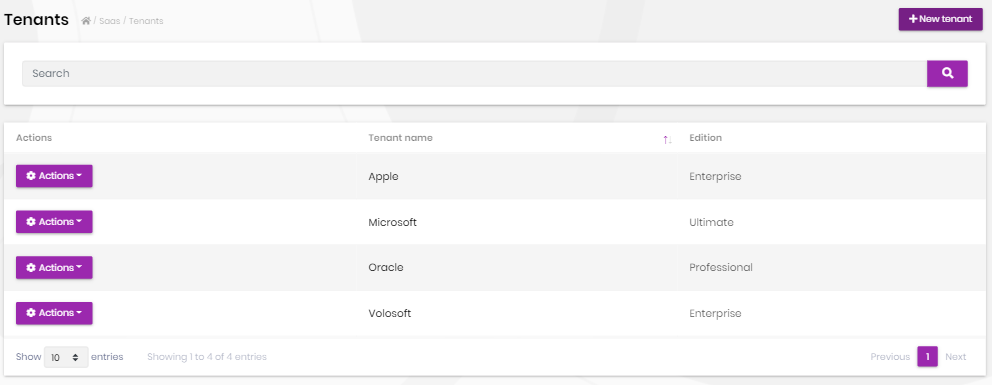
You can create a new tenant or edit a tenant in this page:
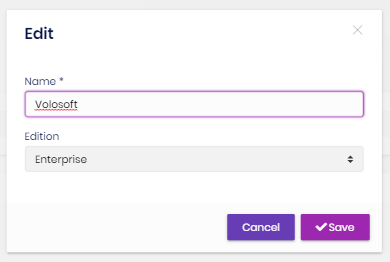
Connection String
You can manage connection string of a tenant in case you want to use a separate database for a specific tenant. If you want to use Host database for a tenant, select "Use the Shared Database" option.
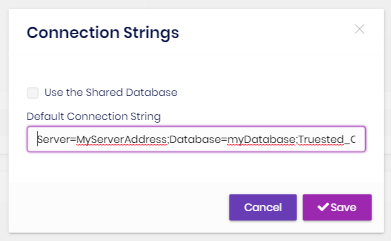
Tenant Features
You can set features of tenants.

Edition management
Editions page is used to manage the editions in your system.
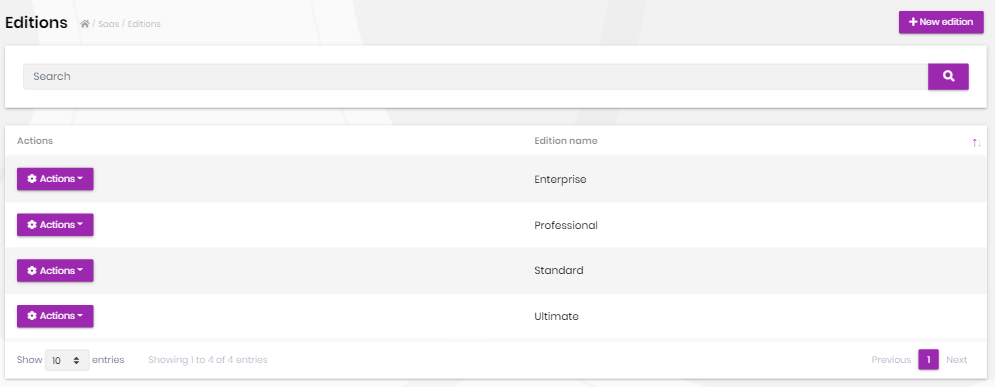
You can create a new edition or edit an existing edition in this page:
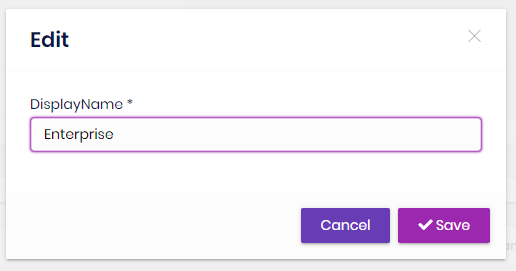
Edition Features
You can set features of an edition in this page:

Data seed
This module adds some initial data (see the data seed system) to the database when you run the .DbMigrator application:
- Creates an
Standardedition.
Internals
Domain layer
Aggregates
This module follows the Entity Best Practices & Conventions guide.
Tenant
A tenant is generally represents a group of users who share a common access with specific privileges to the software instance.
Tenant(aggregate root): Represents a tenant in the system.TenantConnectionString(collection): Connection strings of a tenant.
Edition
An edition is typically a category of features of the application.
Edition(aggregate root): Represents an edition in the system.
Repositories
This module follows the Repository Best Practices & Conventions guide.
Following custom repositories are defined for this module:
ITenantRepositoryIEditionRepository
Domain services
This module follows the Domain Services Best Practices & Conventions guide.
Tenant manager
TenantManager is used to create tenants, change and validate name of tenants.
Application layer
Application services
TenantAppService(implementsITenantAppService): Implements the use cases of the tenant management UI.EditionAppService(implementIEditionAppService): Implements the use cases of the edition management UI.
Database providers
Common
Table / collection prefix & schema
All tables/collections use the Saas prefix by default. Set static properties on the SaasDbProperties class if you need to change the table prefix or set a schema name (if supported by your database provider).
Connection string
This module uses Saas for the connection string name. If you don't define a connection string with this name, it fallbacks to the Default connection string.
See the connection strings documentation for details.
Entity Framework Core
Tables
- SaasTenants
- SaasTenantConnectionStrings
- SaasEditions
MongoDB
Collections
- SaasTenants
- SaasEditions
Permissions
See the SaasHostPermissions class members for all permissions defined for this module.
Angular UI
Installation
In order to configure the application to use the SaasModule, you first need to import SaasConfigModule from @volo/abp.ng.saas/config to root module. SaasConfigModule has a static forRoot method which you should call for a proper configuration.
// app.module.ts
import { SaasConfigModule } from '@volo/abp.ng.saas/config';
@NgModule({
imports: [
// other imports
SaasConfigModule.forRoot(),
// other imports
],
// ...
})
export class AppModule {}
The SaasModule should be imported and lazy-loaded in your routing module. It has a static forLazy method for configuration. Available options are listed below. It is available for import from @volo/abp.ng.saas.
// app-routing.module.ts
const routes: Routes = [
// other route definitions
{
path: 'saas',
loadChildren: () =>
import('@volo/abp.ng.saas').then(m => m.SaasModule.forLazy(/* options here */)),
},
];
@NgModule(/* AppRoutingModule metadata */)
export class AppRoutingModule {}
If you have generated your project via the startup template, you do not have to do anything, because it already has both
SaasConfigModuleandSaasModule.
Options
You can modify the look and behavior of the module pages by passing the following options to SaasModule.forLazy static method:
- entityActionContributors: Changes grid actions. Please check Entity Action Extensions for Angular for details.
- toolbarActionContributors: Changes page toolbar. Please check Page Toolbar Extensions for Angular for details.
- entityPropContributors: Changes table columns. Please check Data Table Column Extensions for Angular for details.
- createFormPropContributors: Changes create form fields. Please check Dynamic Form Extensions for Angular for details.
- editFormPropContributors: Changes create form fields. Please check Dynamic Form Extensions for Angular for details.
Services
The @volo/abp.ng.saas package exports the following services which cover HTTP requests to counterpart APIs:
- SaasService: Covers several methods that performing HTTP calls for
TenantsandEditionspages.
SaasModule Replaceable Components
eSaasComponents enum provides all replaceable component keys. It is available for import from @volo/abp.ng.saas.
Please check Component Replacement document for details.
Remote Endpoint URL
The Saas module remote endpoint URLs can be configured in the environment files.
export const environment = {
// other configurations
apis: {
default: {
url: 'default url here',
},
SaasHost: {
url: 'SaasHost remote url here'
},
SaasTenant: {
url: 'SaasTenant remote url here'
},
// other api configurations
},
};
The Saas module remote URL configurations shown above are optional. If you don't set any URLs, the default.url will be used as fallback.
Distributed Events
This module doesn't define any additional distributed event. See the standard distributed events.


























































